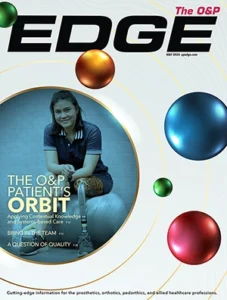Hi all,
I recently spoke with a unilateral transfemoral client who has done some of
his own research into socket designs. This particular client is a
middle-aged male whom lost his leg due to a level crossing accident
approximately 10 years ago. He presents with good strength in both his
residual limb and sound limb as well as his upper limbs and also seems to
have close to full range of motion despite using his prosthesis minimally
over the last two years. The tissue of his residuum is in good condition,
yet has some redundant tissue with a number of invaginations at the distal
end and is subject to daily volume fluctuations.
To date he has been unsatisfied with conventional socket designs partially
due to the pain they cause as his residual limb volume decreases throughout
the day, despite using socks to manage his socket fit. This inspired him to
do his own research into socket designs, which led him to come across the
Socketless Socket from Martin Bionics. He was very enthusiastic about the
design, particularly the swing brim concept and the adjustability it
permits, and he was near certain it would resolve his problems. Without
having had any training with this system, I am unaware of the intricacies of
its design and whether it would be suited to this particular client. I have
reservations about the design, which have been furthered by feedback I have
received from another clinician in Australia who has attempted to fit and
has had difficulty in fitting two clients with the Socketless Socket.
We discussed alternate options for socket design and suspension, and he was
quite enthused by the Boa adjustable socket system with either a suction or
pin suspension. He was not particularly interested in elevated vacuum for
volume control. However, he was quite determined to use the retro-fittable
swing brim or another design with the same concept in mind. I was curious to
know if anyone has had any experience with a swing brim or hammock seat as
opposed to a rigid ischial seat/containment brim. Does it have any impact on
prosthesis control? Does the flexible brim/hammock stretch over time, or
does it remain strong enough to support the amputee weight and prevent them
from taking weight on the distal end? Is it simple to retro fit to an
existing socket? Has it improved comfort amongst any of your transfemoral
clients? Would it be suited to a client such as that described above, if he
is wishing to increase his activity to full time prosthetic use?
Any assistance would be much appreciated.
Kind regards
Mitch
Mitch Farrar
BEng(Biomedical)/BMedSci MCPO MAOPA MISPO
Unit 36, 148 Chesterville Road
Moorabbin. Victoria 3189
(m) (03) 9532 5098
Promotion Prosthetics
@pmprosthetics
#Promotion_Prosthetics




